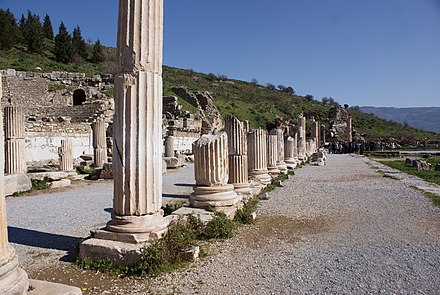friend
Basilica
In Ancient Roman architecture, a basilica was a large public building with multiple functions that was typically built alongside the town's forum.
The basilica was in the Latin West equivalent to a stoa in the Greek East. The building gave its name to the architectural form of the basilica.

Origins
The Latin word basilica derives from Ancient Greek:βασιλική στοά , romanized: basilikḗ stoá, lit. 'royal stoa'. The first known basilica—the Basilica Porcia in the Roman Forum—was constructed in 184 BC by Marcus Porcius Cato (the Elder).[2] After the construction of Cato the Elder's basilica, the term came to be applied to any large covered hall, whether it was used for domestic purposes, was a commercial space, a military structure, or religious building.[2]
Roman Republic
Long, rectangular basilicas with internal peristyle became a quintessential element of Roman urbanism, often forming the architectural background to the city forum and used for diverse purposes.[6] Beginning with Cato in the early second century BC, politicians of the Roman Republic competed with one another by building basilicas bearing their names in the Forum Romanum, the centre of ancient Rome. Outside the city, basilicas symbolised the influence of Rome and became a ubiquitous fixture of Roman coloniae of the late Republic from c. 100 BC. The earliest surviving basilica is the basilica of Pompeii, built 120 BC.[6] Basilicas were the administrative and commercial centres of major Roman settlements: the "quintessential architectural expression of Roman administration".[7] Adjoining it there were normally various offices and rooms housing the curia and a shrine for the tutela.[8] Like Roman public baths, basilicas were commonly used as venues for the display of honorific statues and other sculptures, complementing the outdoor public spaces and thoroughfares.[9]

Beginning with the Forum of Caesar (Latin: forum Iulium) at the end of the Roman Republic, the centre of Rome was embellished with a series of imperial fora typified by a large open space surrounded by a peristyle, honorific statues of the imperial family (gens), and a basilica, often accompanied by other facilities like a temple, market halls and public libraries.[6] In the imperial period, statues of the emperors with inscribed dedications were often installed near the basilicas' tribunals, as Vitruvius recommended. Examples of such dedicatory inscriptions are known from basilicas at Lucus Feroniae and Veleia in Italy and at Cuicul in Africa Proconsolaris, and inscriptions of all kinds were visible in and around basilicas.[11]

Ruins of the Basilica-stoa at Ephesus
The 4th century Basilica of Maxentius, begun by Maxentius between 306 and 312 and according to Aurelius Victor's De Caesaribus completed by Constantine I, was an innovation.[32][33] Earlier basilicas had mostly had wooden roofs, but this basilica dispensed with timber trusses and used instead cross-vaults made from Roman bricks and concrete to create one of the ancient world's largest covered spaces: 80 m long, 25 m wide, and 35 m high.[3][32] The vertices of the cross-vaults, the largest Roman examples, were 35 m.[32] The vault was supported on marble monolithic columns 14.5 m tall.[32] The foundations are as much as 8 m deep.[17] The vault was supported by brick latticework ribs (Latin: bipedalis) forming lattice ribbing, an early form of rib vault, and distributing the load evenly across the vault's span.[17] Similar brick ribs were employed at the Baths of Maxentius on the Palatine Hill, where they supported walls on top of the vault.[17] Also known as the Basilica Constantiniana, 'Basilica of Constantine' or Basilica Nova, 'New Basilica', it chanced to be the last civic basilica built in Rome.[3][32]


